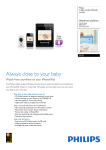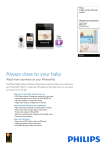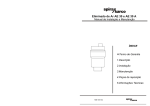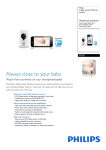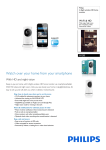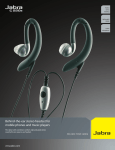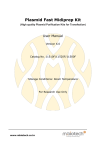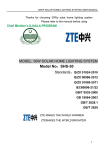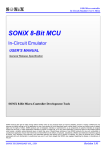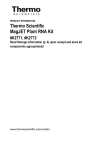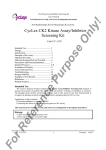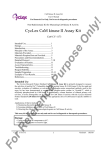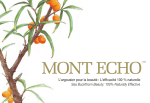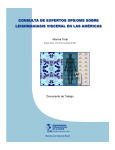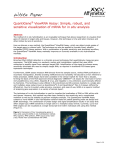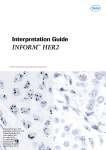Download User Manual - TopoGEN, Inc.
Transcript
© Copyright TopoGEN, Inc., 2012. All rights reserved. User Manual Purified E. coli DNA Gyrase and Relaxed DNA Kit (plasmid based). Catalog Number TG2000G-1KIT 100 Reaction Set [50 ug DNA] Catalog Number TG2000G-3KIT 500 Reaction Set [250 ug DNA] Catalog Number TG2000G-5KIT 1000 Reaction Set [500 ug DNA] Catalog Number TG2000G-7KIT 2000 Reaction Set [1 mg DNA] Shipping and Storage of Reagents The kit is shipped on dry ice. The DNAs should be stored at 4° C and the buffers stored at -20° C upon receipt. Avoid frequent freeze/thaw cycles with the plasmid as this may contribute to DNA breakage. Store enzyme at -70° C. We also recommend that the enzyme be aliquoted after the first thaw (repeated rounds of freeze/thaw may cause loss of activity); the enzyme activity is stable for 1-3 days on ice. TopoGEN, Inc. 108 Aces Alley, Port Orange, Florida 32128, USA. Tel: 614-451-5810 Fax: 614-559-3932 Orders [email protected], Support: [email protected] Website: www.topogen.com Product Application and Disclaimer. This product is not licensed or approved for administration to humans or animals. It may be used with experimental animals only. The product is for in vitro research diagnostic studies only. The product in non-infectious and non-hazardous to human health. This information is based on present knowledge and does not constitute a guarantee for any specific product features and shall not establish a legally valid contractual relationship. TopoGEN, Inc. shall not be held liable for product failure due to mishandling and incorrect storage by end user. TopoGEN’s liability is limited to credit or product replacement. E. coli DNA Gyrase User Manual I. Introduction A. Summary This kit contains purified bacterial (E. coli) DNA Gyrase purified to homogeneity (based on SDS-PAGE). DNA Gyrase is prepared from overexpressing strains and is supplied as purified holoenzyme in an A2B2 complex. The enzyme is supplied at the unit concentration given on the above quality control data provided with the kit. The DNA Gyrase is stored in a stabilization buffer [50 mM Tris-Cl pH 7.5, 100 mM KCl, 2 mM dithiotreitol, 1 mM EDTA, 50% glycerol]. Also included is substrate DNA supplied in TE (10 mM Tris-HCl, 1 mM EDTA, pH 7.5). DNA concentration of the relaxed DNA is provided on the label of the tube. The DNA Gyrase Assay Kit is based on supercoiling action on a relaxed plasmid DNA substrate provided (pHOT1, which is a derivative of pBR322) and roughly 2.7 KB. One unit of gyrase will supercoil 500 ng (0.5ug) in 1 hr at 37oC under conditions defined below. The reaction mechanism is describe below in Fig. 1. The enzyme introduces negative supercoils into a relaxed pHOT1 plasmid substrate via a sign inversion model. An energy co-factor (ATP) is required for the complete supercoiling reaction. The inset gel image in Fig. 1 represents a typical substrate and product (supercoiled DNA) result based on an agarose gel that lacks ethidium bromide. These non-EB gels are ideal for detecting gyrase activity as attested by the excellent resolution between supercoiled and relaxed DNA forms. Figure 1. The Gyrase reaction. TopoGEN, Inc. www.topogen.com Protocol TG2000GKIT Version 2 032312 E. coli DNA Gyrase User Manual C. DNA Gyrase Quality Control. 1. A test for nuclease contamination was carried out by assaying for the formation of linear Kinetoplast DNA (kDNA) and linear plasmid DNA. Incubations of 1 µg of catenated kDNA or supercoiled pUC19 DNA (4 hrs. at 37°C in the presence of 10 mM MgCl2) were performed. Linear DNA or breakdown products were not generated under these conditions. 2. The A and B subunits are >95% pure based upon SDS-PAGE and certified to be endonuclease free. 3. Note: with high input levels of DNA gyrase, a small amount of linear DNA may be detected due to spontaneously aborted reactions. This is normal. D. Dilution Buffer Dilution of purified DNA gyrase should be performed in 50 mM Tris-Cl (pH 7.5), 100 mM NaCl, 2 mM dithiothreitol, 1 mM EDTA and 50% glycerol. E. Supercoiling Assay Conditions One unit of gyrase is typically incubated with 0.1 to 0.5 ug of relaxed plasmid DNA in a reaction volume of 20-30 ul for 1 hr. at 37oC in assay buffera. a Assay buffer (1x recipe is shown below; kit includes a 5x stock based on this formula): 35 mM Tris-Cl pH 7.5 24 mM KCl 4 mM MgCl2 2 mM dithiothreitol 1.8 mM spermidine 1 mM ATP 6.5% glycerol 0.1 mg BSA/ml F. Relaxed DNA Quality Control Tests: 1. Purity was evaluated spectrophotometrically using A260:A280 readings. 2. Incubations with gyrase buffer alone at 37oC for 60 min did not result in formation of nicked or linear DNA species. 3. Relaxation of supercoiled DNA was carried out using TopoGEN’s purified DNA topoisomerase I (TG2005H-RC1). Greater than 95% of the plasmid is relaxed under these conditions. TopoGEN, Inc. www.topogen.com Protocol TG2000GKIT Version 3 032312 E. coli DNA Gyrase User Manual G. Kit Contents. Volumes are given for the TG2000G-1KIT size. (For the larger kits size, multiply volumes as appropriate, see page 1 for Kit sizes). Relaxed pHOT1 DNA (50 ug total) DNA concentration is specified on page 1. Supercoiled pHOT1 DNA (25 ul in gel loading buffer). Load 2 ul as a marker. 5x Gyrase assay buffer (600 ul) 1x buffer contains recipe is given above. Dilution buffer (600 ul). Dilute gyrase with this buffer. Recipe for dilution buffer given above. 5x Stop Buffer/gel loading dye (600 ul): 5x buffer is 5% Sarkosyl, 0.125% bromophenol blue, 25% glycerol. Purified DNA gyrase (unit definition given on page 1). H. Protocol for a typical reaction mixture (final volume of 20 ul) Protocol Summary: Reaction volumes should be 20-30 ul final volume (generally limited by volume that can be loaded onto the gel). Reactions are assembled in microfuge tubes with water, buffer and substrate pHOT1 relaxed DNA. The gyrase should be added last and the reactions incubated at 37oC for 15-60 min. (or longer as appropriate) then terminated with the stop/load buffer, proteinase K digested, extracted and loaded onto an agarose gel (note, DO NOT add ethidium bromide (EB) to gel or gel buffer during electrophoresis, use EB to stain the gel AFTER electrophoretic separation). In some cases, you may wish to run an EB gel (0.5ug/ml EB IN GEL AND BUFFER) in order to resolve nicked and linear DNA from circular substrate (relaxed pHOT1) and supercoiled DNA products. If you are unsure which to run, we recommend that you try running both gel systems and divide your samples into two parts. Usually there is sufficient DNA in the reaction to run two gel systems. TopoGEN, Inc. www.topogen.com Protocol TG2000GKIT Version 4 032312 E. coli DNA Gyrase User Manual I. Sample reaction (20 ul, order of addition is shown): Sterile Distilled H20: Vary as needed to bring volume up to 20 ul 5x Assay Buffer: 4u pHOT1 Relaxed DNA: 1 ul (vary as needed)* *The amount of relaxed DNA depends on sensitivity and detection methods. With routine staining using ethidium bromide, about 250 ng of DNA is usually sufficient; however, less may be used with more senstitive stains. Gyrase: 1 ul (always add enzyme last on ice and transfer all tubes to heat block to initiate reaction sequence). Procedure for a non-EB gel analysis of DNA Gyrase Supercoiling: 1. Incubate 30- 60 min at 37oC. 2. Add 1/5 vol of stop buffer/loading dye. 3. Add proteinase K to 50 ug/ml, digest for 10-30 min at 37oC (optional step). 4. Add 20 ul of Chloroform:isoamyl alcohol (24:1 mixture), vortex briefly, withdraw blue, aqueous phase. 5. Load blue phase onto a 1% agarose (50x TAE buffer: 242 g Tris base, 57.1 ml glacial acetic acid, 100 ml 0.5M EDTA). 6. Electrophorese until dye travels 60-75% down the gel. 7. Stain with 0.5 ug/ml ethidium bromide for 30 min (caution, EB is a mutagen, WEAR GLOVES). 8. Destain (distilled water) for 10-30 min room temperature (handle gel with gloves). 9. Photograph using UV transilluminator. J. Analysis of reaction products by electrophoresis: For each gel, run a negative control (relaxed DNA lacking gyrase). The negative control should look very different from the gyrase reaction products (which will be faster migrating, supercoiled DNA forms; see Fig. 2). TopoGEN, Inc. www.topogen.com Protocol TG2000GKIT Version 5 032312 E. coli DNA Gyrase User Manual J. Frequently asked questions. What are the critical controls to allow me to clearly identify drug that is affecting DNA gyrase using this assay? - Marker DNAs (supercoiled, linear DNAs) are extremely important. - Be sure to run a positive DRUG control (like a fluoroquinolone) to demonstrate good cleavage activity. You should see an increase in linear DNA. - Include a negative control (either no drug or a topo II drug such as etoposide). VP16 or etoposide is not supplied but we have it available. - Be sure to check solvent effects. Solvents like DMSO or methanol are used to dissolve some test drugs. Test with a control reaction lacking drug but with solvent (e.g. 1% DMSO). What kind of agarose should I buy? Any nuclease-free agarose of reasonable quality from any number of sources can be used (Sigma-Aldrich works). What is the best gel buffer to use? Agarose gels (1%) and running buffers can be any standard nondenaturing electrophoresis buffer (example, to prepare a 50x of TAE Gel Buffer: 242 g Tris base, 57.1 ml glacial acetic acid and 100 ml of 0.5 M EDTA). Dilute to 1x to use for gel separations. Be sure that the gel also has 1x TAE buffer. Should I run EB or Non-EB gels and how do I run the EB gels? - In general, 1% gels in the absence of Ethidium Bromide (EB), can be used (these gels are ideal for testing enzyme activity); however, the nicked open circular DNA product cannot be clearly identified in this gel system. As noted above, an EB containing gel (0.5 ug/ml, EB in gel and buffer) will improve the resolution of cleavage products (nicked open circular and linear DNA). Be sure to destain with water for 15 min prior to photodocumenting your data. - In some cases, depending on how the gel is run, the topoisomer distribution can interfere with your ability to see the cleavage products; however, EB gels remove this complication. - IMPORTANT: If unsure about whether to run an EB or Non-EB gel, we suggest that you run both. Simply divide your reactions into equal parts and run two gels at the same time. In this way, you will be sure to see all reaction products and enhance your interpretation of the experiment. With all markers in the gel system (supercoiled, relaxed, linear for example) you will obtain very clear and unambiguous results. What are the running conditions in terms of time and voltage? - Run gels at 1.5-2 V/cm (measured between electrodes) until the dye front has traveled about 80% - After running, non-EB gels should be stained with EB (0.5 ug/ml) for 15-30 min and then destained in water or buffer for 15 min prior to photodocumentation. - EB gels are run in the presence of 0.5 ug/ml (in gel and running buffer), then destained with water for 15 min prior to photodocumentation. - IMPORTANT: Try not to run the gels overnight but keep your electrophoresis times to less than 1-2 hrs. Long run times cause band diffusion and degrade the quality of your gel results. TopoGEN, Inc. www.topogen.com Protocol TG2000GKIT Version 6 032312 E. coli DNA Gyrase User Manual What reaction volumes do you recommend for these assays? - Reaction volumes should be 20-30 ul final volume (limited by the volume that can be loaded into the wells of the agarose gel). - The reactions should be assembled on ice in microfuge tubes (water, buffer, and DNA, test compound and enzyme, which should be added last). - After adding enzyme, the tubes should be transferred to a heating block to initiate the reaction. Does it matter whether I run a large format gel or a minigel? - Either will work. Minigels are very convenient and give reasonably fast run times. - The actual shape and size of the well slot is a factor in how well your bands resolve. It is best to use a comb that gives a long and thin rectangular Are the termination conditions critical for detecting cleavages? - Yes. Reactions should be incubated 30 min (37°C), terminated by rapid addition of 1/10 volume of 10% SDS followed by digestion with 50 ug/ml proteinase K prior to loading the gel. SDS is added to reactions at 37° to facilitate trapping the enzyme in a cleavage complex. - Also, if the reactions are heated, cooled or treated with high salt prior to adding SDS, the topo breakage and resealing equilibrium may be altered and breaks can reseal. Why is proteinase K required? - Drugs that trap topo/DNA complexes will induce covalent complexes between DNA and protein (topo) and this protein must be removed (degraded). Failure to do so will prevent detection of the cleavage products. - If the reactions are heated, cooled or treated with high salt prior to SDS, the topo DNA breakage and resealing equilibrium may be altered and breaks can reseal. Can you help us with data interpretation? - Yes, we can definitely help! The best way to proceed is to send us your data ([email protected]) with a full description of the experiment. We will get back to you quickly with feedback. Can you show us some real gel data and discuss the results? - Yes, we can. The results and a helpful discussion is shown in Fig. 2 (see legend). Any further questions or comments, please feel free to contact us: [email protected] TopoGEN, Inc. www.topogen.com Protocol TG2000GKIT Version 7 032312 E. coli DNA Gyrase User Manual Rel DNA + Gyrase Relaxed Topoisomers Gyrase Linear DNA + Ciproflox Linear DNA Linear DNA Supercoiled DNA Figure 2. Gyrase Reaction Products Resolved on a Non-EB Gel system Gyrase reactions were carried out in a final volume of 20 ul (see above protocol). Reactions were terminated with 1% SDS, digested with proteinase K and extracted with CIA. The Gel were run at 50v for 45-50 min and stained with EB (non-EB gel) per protocols given above. The data show the positions of relaxed DNA as well as gyrase reaction products (supercoiled DNA). The reaction with a fluoroquinolone (ciprofloxacin) yields a linear DNA cleavage product in the last lane on the right (marked with a small triangle). For full interpretation of gel data, it is important to include relaxed DNA, linear DNA markers as well as a control gyrase and gyrase+drug, as shown here. TopoGEN, Inc. www.topogen.com Protocol TG2000GKIT Version 8 032312








